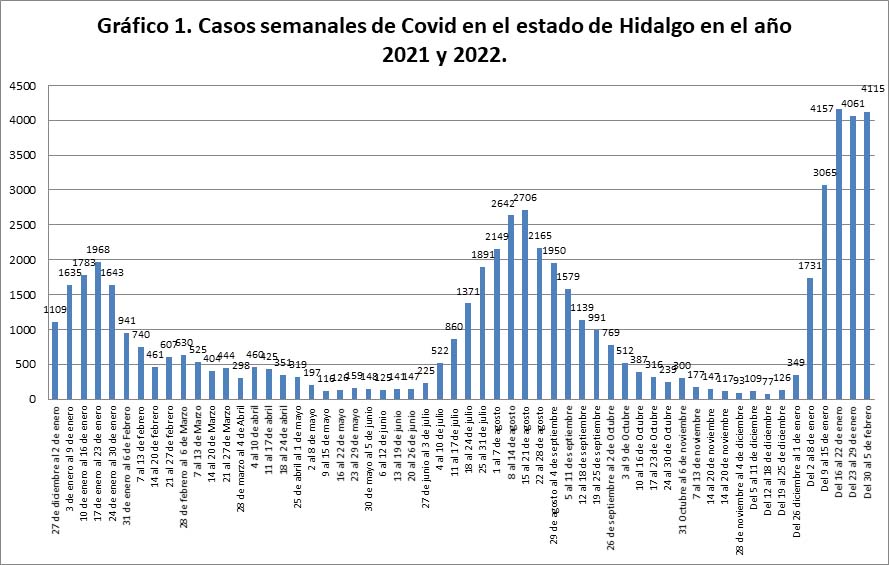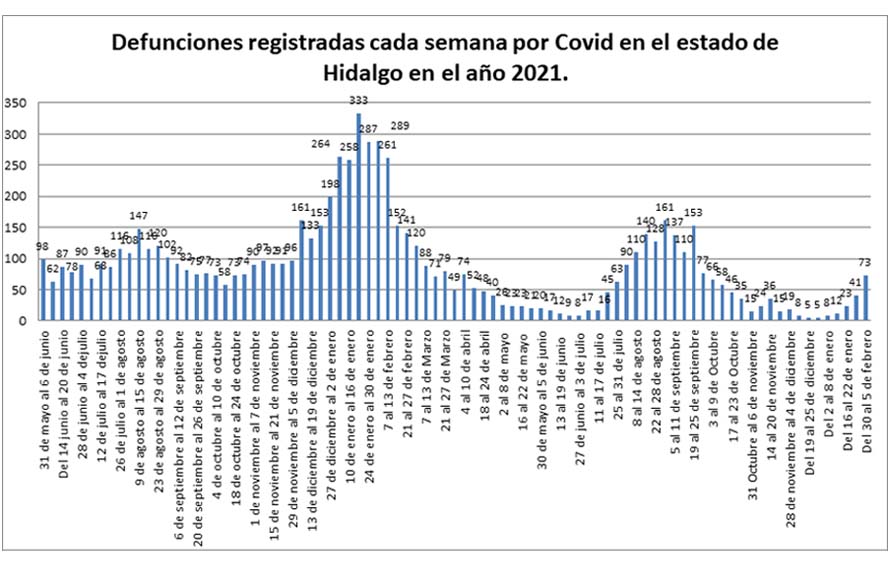Very high plateau of coronavirus infections in Hidalgo

José Aurelio Granados Alcantar
Ph.D. in Regional Development and Territorial Planning
In the last three weeks, the levels of coronavirus infections have reached more than 4,000 cases per week, indicating that the transmission of infections has stabilized at very high levels.
The previous week it appeared that the decline had begun, as the number of cases during that time period showed a small decrease from the previous week, with 4,61 coronavirus infections reported from January 23-29, versus 4,157 reported from January 16-22.
However, in the last week, from January 30 to February 5, the intensity of infections increased again, with 4,115 infections; although this increase is not very strong, since there were only 54 more than in the previous period, this shows that infections are not decreasing, and we hope that in the coming days the decrease in cases will be more intense (See Graph 1).
With this level of infections, hospitalizations have increased; as of February 5, Hidalgo was the third entity with the highest occupancy of general beds with 55.2%, only surpassed by Aguascalientes (56.7%) and Nuevo Leon (62.9%). Although it is worth noting that General Bed Occupancy in Hidalgo has decreased, on January 30 it reached 60.9%.
In the Occupancy of Beds with Ventilator, the situation is less favorable since only 27.8% of this type of beds are occupied; in this category, the state is in eleventh position at the national level. Regarding the Occupancy with Ventilator in Intensive Care Units (ICU), the situation is more worrisome since from February 4 to February 5 this indicator went from 30.7% to 61.6%, that is, an increase of almost 30% of COVID -19 patients who are in a very delicate situation.
Each week this year has seen an increase in deaths compared to the previous week; the week from January 29 to February 5, 74 deaths were recorded as a result of the coronavirus; the previous week, from January 23 to 29, there were 41 (see Table 2). Unfortunately, this trend will continue in the coming weeks due to the high levels of infections and, as we saw in the previous paragraph, due to the increase in the number of ICU Ventilator Beds (see IRAG Network Information System. https://www.gits.igg.unam.mx/red-irag-dashboard/reviewHome).
According to the database entitled "Open Data" by COVID-19, of the 187 deaths registered in Hidalgo this year, 58.8% have been women and 41.2% men, half of the people were over 63 years old, 25% between 45 and 62 years old and the same percentage under 44 years old.
In other words, the trend is the same as in other waves of contagion: the probability of dying from the consequences of the coronavirus is very high among people over 60 years of age. More than 25% of these deaths resided in the municipalities of the Pachuca Metropolitan Zone: Pachuca (20.9%) and Mineral de la Reforma (7.1%).
This number of deaths is worrisome because these municipalities only concentrate 16% of the population of Hidalgo, which reflects an over-mortality with respect to population size; but it is more alarming because these municipalities are supposed to concentrate the best public and private health services in the state. In addition, the vaccination campaign has been more intense than in other more marginalized municipalities of the state.

Source: Own elaboration based on SSA Daily Technical Communiqués. https://www.gob.mx/salud/documentos/

Source: Own elaboration based on SSA Daily Technical Communiqués. https://www.gob.mx/salud/documentos/
WHO IS...?
José Aurelio Granados Alcantar holds a PhD in Regional Development and Territorial Planning from the University of Barcelona, Spain. He is a research professor in the academic area of Sociology and Demography, Institute of Social Sciences and Humanities (ICSHu) at the Autonomous University of the State of Hidalgo (UAEH). He is a member of the National System of Researchers, level I.